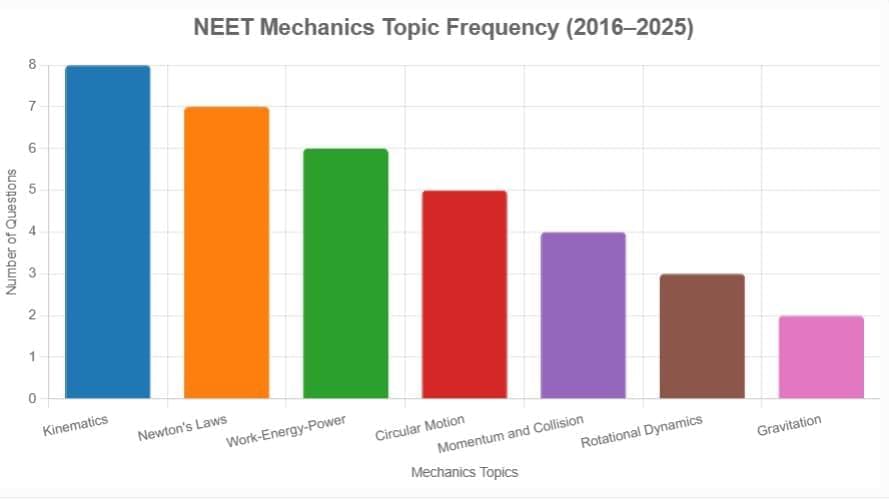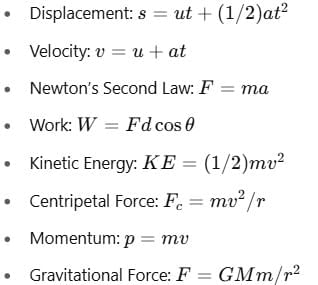How to Study Mechanics (Kinematics and Dynamics) for NEET | Physics Class 11 PDF Download
Introduction
Step into the high-scoring and concept-rich unit of Modern Physics—a key pillar of NEET Physics. With 4–6 questions every year, this unit includes essential topics like the Photoelectric Effect, Atomic Structure, and Nuclear Physics. This guide distills the core syllabus, high-yield concepts, and scoring strategies into a clear plan of action, helping you approach Modern Physics with confidence and clarity

Understanding NEET Mechanics (Kinematics and Dynamics) Syllabus
Start by knowing exactly what’s expected. The following topics frequently appear in NEET

Kinematics (1D and 2D Motion)
Newton's Laws of Motion
Work, Energy, and Power
Circular Motion
Momentum and Collision
Rotational Dynamics
Gravitation
Friction
Simple Harmonic Motion (SHM)
Center of Mass
Focus on Core Concepts
Right after syllabus clarity, zoom into topics that carry the most weightage in NEET.
Kinematics (8 questions): Displacement, velocity, and acceleration in 1D and 2D.
Newton's Laws (7 questions): Force, mass, and acceleration applications.
Work-Energy-Power (6 questions): Kinetic and potential energy, work done.
Circular Motion (5 questions): Centripetal force and banking of roads.
Momentum and Collision (4 questions): Conservation laws and elastic/inelastic collisions.
Rotational Dynamics (3 questions): Torque and moment of inertia.
Gravitation (2 questions): Gravitational force and potential.
How to Study Important Topics
After identifying the core areas, here’s a structured approach to study them effectively
Kinematics
Focus: Master displacement (s = ut + (1/2)at²) and velocity (v = u + at) in 1D and 2D; understand kinematic equations, often tested with projectile motion.
Method: Solve 10–15 problems daily on motion graphs, derive equations, and analyze projectile trajectories.
Newton's Laws
Focus: Grasp F = ma and its applications; frequently tested with Newton's three laws in pulley and inclined plane problems.
Method: Practice 5–10 problems daily on force balance, apply Newton's laws, and draw free-body diagrams.
Work-Energy-Power
Focus: Understand work (W = Fd cosθ) and kinetic energy (KE = (1/2)mv²); often tested with conservation of energy.
Method: Solve 5–10 problems daily on work-energy theorems, derive relationships, and analyze energy transformations.
Circular Motion
Focus: Learn centripetal force (Fc = mv²/r); commonly tested with banking of roads and uniform circular motion.
Method: Practice 5–10 problems daily on centripetal acceleration, derive F_c, and study car-on-curve scenarios.
Resources for Important Topics
Build a solid foundation using the right study materials
Core Materials: NCERT Physics Class 11 (Chapter 3: Motion in a Straight Line, Chapter 4: Motion in a Plane, Chapter 5: Laws of Motion, Chapter 6: Work, Energy and Power), HC Verma's Concepts of Physics (Mechanics), DC Pandey's Objective Physics for NEET.
Supplementary Resource: EduRev app (EduRev) for video lectures, practice questions, and mock tests tailored to NEET preparation.
Memorize and Understand Formulas
Memorizing all the formulas can certainly give you an edge in the main exam. The following is a list of formulas that are essential for solving both conceptual and numerical questions with speed and accuracy.
Essential Formulas

Learning Approach
Develop a formula sheet and derive equations (e.g., kinematic equations) to deepen understanding.
Use flashcards for quick recall.
Apply formulas in numerical problems to reinforce concepts and avoid rote learning.
Consistent Numerical Practice
- Daily Objective: Solve 20–30 numerical problems daily, prioritizing high-frequency topics: Kinematics, Newton's Laws, Work-Energy-Power, and Circular Motion.
- Problem Sources: DC Pandey's Objective Physics, past NEET question papers, and EduRev app question banks.
- Focus Areas: Kinematic motion calculations, force applications, work-energy problems, and circular motion dynamics.
- Strategy: Time practice sessions to 1–2 minutes per question and maintain an error log to address recurring mistakes.
Analysis of Previous Years' Papers
- Purpose: Identify patterns and difficulty levels in Mechanics questions.
- Scope: Review NEET Physics papers from 2016–2025, focusing on Kinematics (e.g., projectile motion), Newton's Laws (e.g., pulleys), and Work-Energy-Power (e.g., conservation).
- Expectation: Anticipate 8–12 questions, with a strong likelihood of Kinematics and Newton's Laws problems.
- Resource: Utilize EduRev app (EduRev) for past papers.
Mock Test Practice
- Objective: Simulate exam conditions to improve time management and accuracy.
- Goal: Aim for 1–2 minutes per question during timed mock tests.
- Resource: Use EduRev app (EduRev) for mock tests and analyze performance on high-priority topics.
Exam Day Tips
Quick Formula Review: Before the exam, glance at your formula sheet for Kinematics, Newton's Laws, and Work-Energy-Power to reinforce key equations.
Prioritize High-Weightage Questions: Start with Kinematics and Newton's Laws questions, as they are more likely to appear and often solvable with clear formulas.
Time Allocation: Spend 1–2 minutes per question; skip complex numericals initially and return if time permits.
Check Units and Calculations: Ensure units are consistent (e.g., m/s² for acceleration) and double-check multi-step calculations, especially for Circular Motion.
Stay Calm: If stuck on a collision or gravitation problem, take a deep breath and break it into smaller steps (e.g., use conservation laws).
Additional Preparation Strategies
Consistency: Maintain a daily commitment of 2 hours to Mechanics for steady progress.
Precision: Verify calculations in multi-step numericals (e.g., Kinematics, Work-Energy-Power) to minimize errors.
Time Management: Allocate 1–2 minutes per question initially, revisiting complex problems as needed.
Well-being: Prioritize 6–8 hours of sleep, incorporate 5-minute breaks hourly, and maintain a balanced diet to support focus and stamina.
Motivation: Set achievable short-term goals (e.g., mastering Kinematics) and acknowledge progress to sustain momentum.
This structured guide, grounded in NEET trends and enriched with targeted strategies, is your ultimate roadmap to conquer Mechanics (Kinematics and Dynamics). Focus on Kinematics, Newton's Laws, Work-Energy-Power, and Circular Motion to maximize your Physics score. Best wishes for your NEET preparation!
|
96 videos|367 docs|98 tests
|
FAQs on How to Study Mechanics (Kinematics and Dynamics) for NEET - Physics Class 11
| 1. What are the core concepts in Mechanics (Kinematics and Dynamics) that NEET aspirants should focus on? |  |
| 2. How can students effectively memorize and understand formulas in Mechanics for NEET preparation? |  |
| 3. What strategies can be employed for consistent numerical practice in Mechanics? |  |
| 4. How important is the analysis of previous years' papers for NEET preparation in Mechanics? |  |
| 5. What tips can be followed on exam day to ensure optimal performance in the Mechanics section of NEET? |  |
















